Oeuvre Maternelle des Couveuses d’Enfants, Paris
Dr. Alexandre Lion’s storefront establishments were known as “Oeuvre Maternelle des Couveuses d’Enfants.” The first branch was in Nice, and additional branches are known to have existed in Paris, Marseille, Bordeaux, Lyon, Liege, Brussels, and New York City. There may have been others. The establishment at 26 B. Poissonniere in Paris is the best documented. The storefront and an entry ticket are shown below.
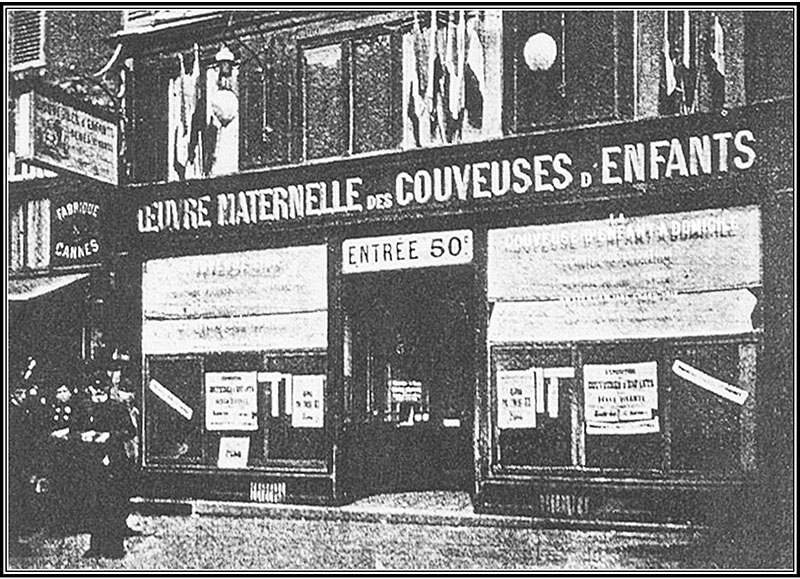
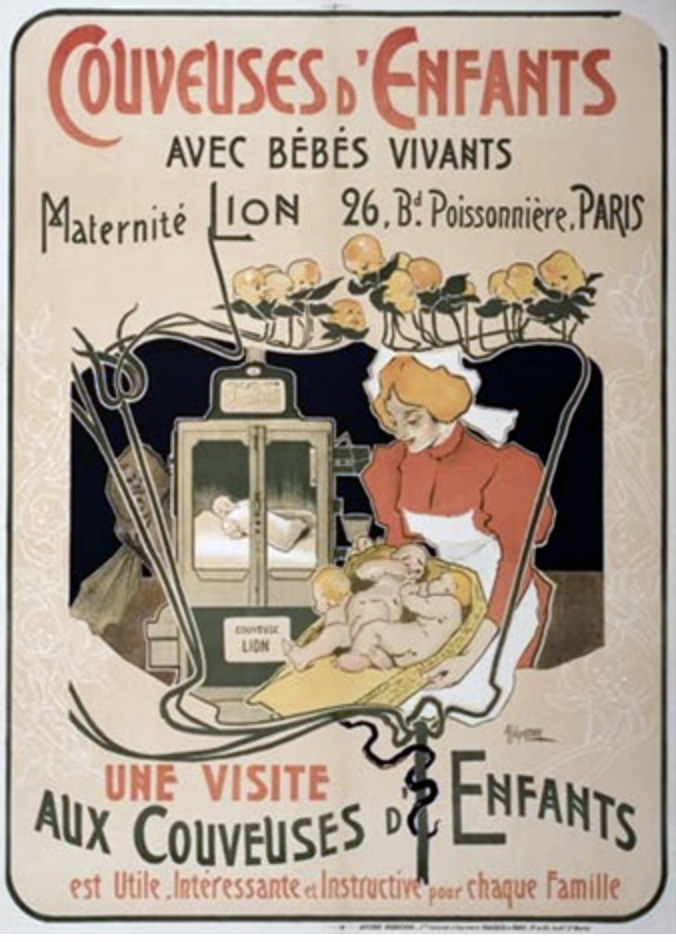
The image below shows five of the Lion Incubators in use, circa 1896, in Lion’s establishment in Paris, France. Dr. Lion is standing by the end incubator.
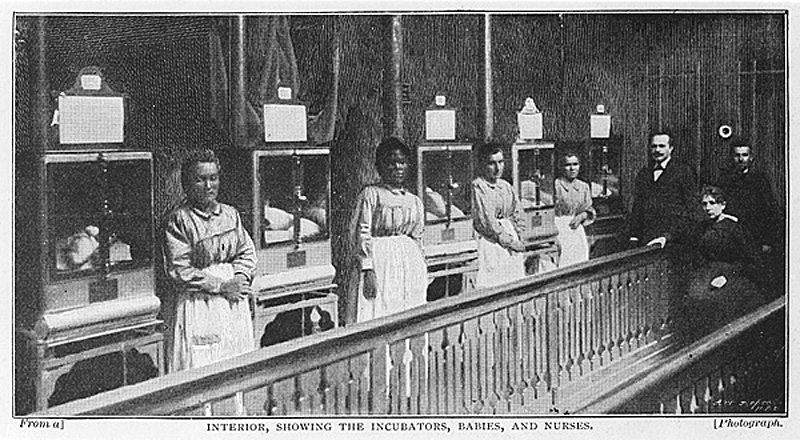
A similar picture can be found in the popular journal Lectures pour Tous, October, 1900:
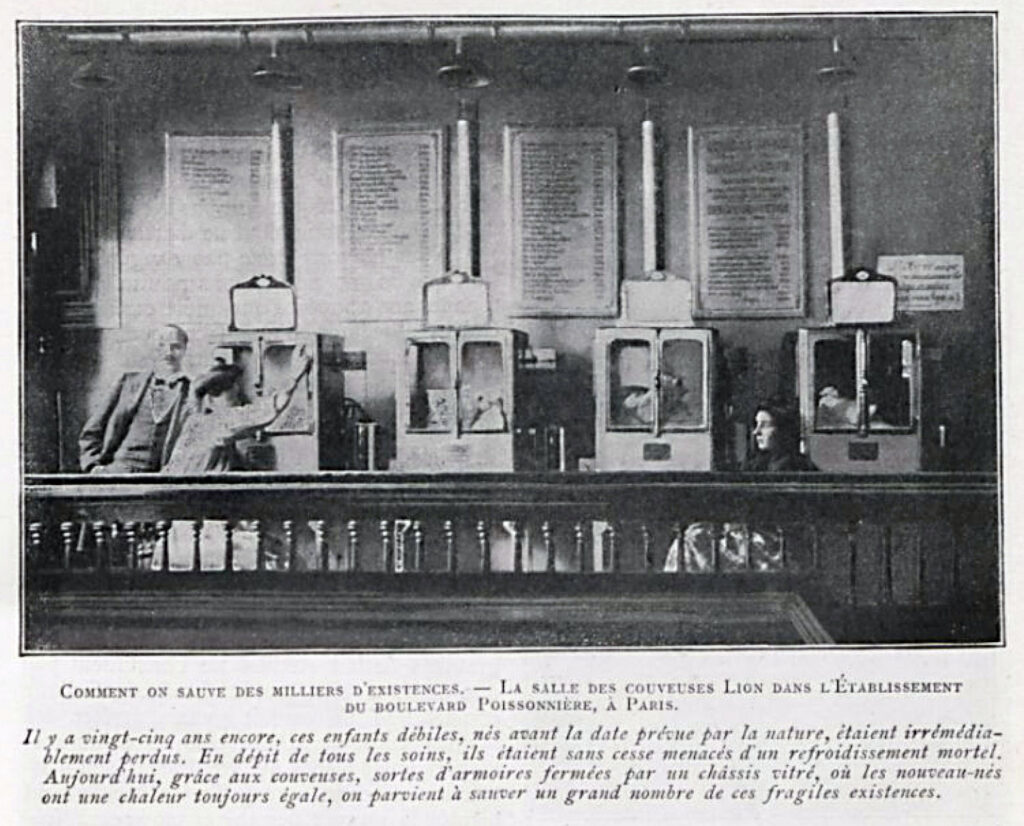
In addition to its use in his own establishments, Lion’s incubator design was licensed and manufactured by Paul Altmann in Berlin and by Kny-Scheerer Co. in the US. It was widely used in exhibitions and sideshows throughout Europe and the United States, beginning with the Kinder-Brutanstalt (“child hatchery”) at the Berlin Exposition of 1896 and the Victorian Era Exhibition at Earl’s Court of 1897, followed by the Trans-Mississippi Exposition of 1898 in Omaha, Nebraska and many others. Advertisements for the incubator can be found in Lion’s own booklets and in medical equipment catalogs of the era.
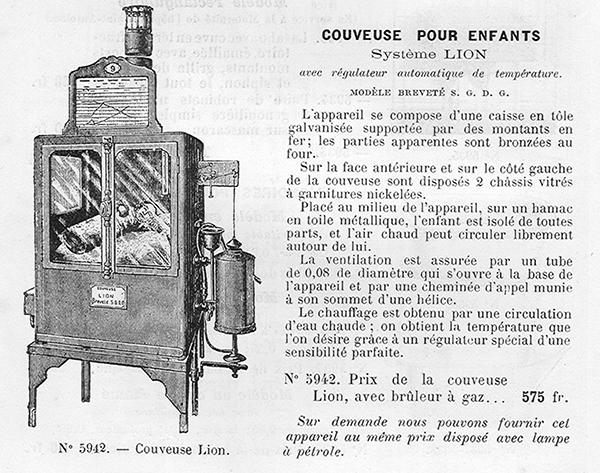
Dr. Lion prepared an elaborate booklet with information about survival, feeding, and his incubators, which was distributed in the storefront institutes and also at expositions. We have several examples of this booklet with different dates, they mainly differ in the lists of awards at the front and the lists of installations at the end. Hotlinks to scans of the booklets can be found in the list below.
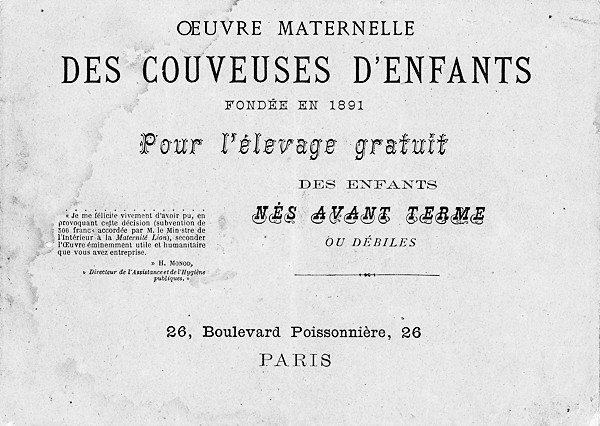
Dr. Lion created souvenir postcards for all of his storefront locations and exhibitions, which must have been very popular because they can be found in abundance on eBay and other sites. Most of these were based on a common template, where only a few words of text were changed for each location. The two below were for the Paris branch of Oeuvre Maternelle des Couveuses d’Enfants.
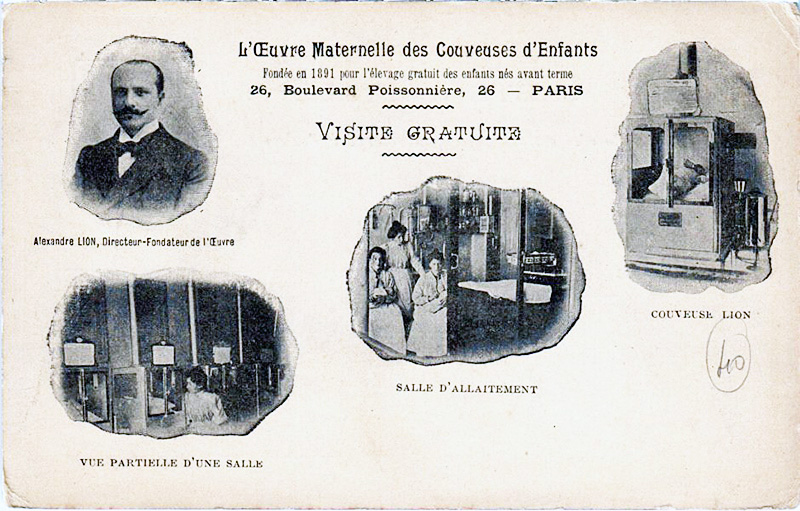
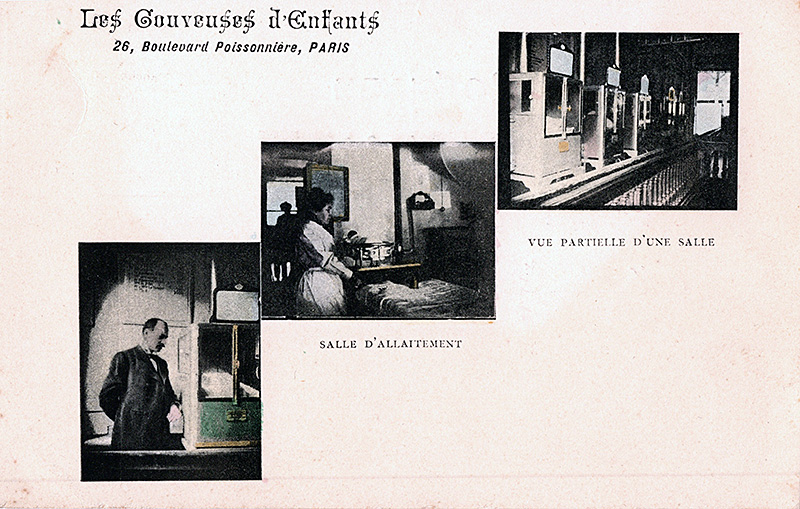
For more information about Dr. Lion and the Paris operation, see James Walter Smith’s article hotlinked below. For more information about the New York branch, see the Leslie’s Weekly article hotlinked below.
“Alexandre Lion’s incubator was patented in 1889. He was a physician in Nice, France, whose father was an inventor. Similar to the cost-driven motivation that permeates today’s medical practices, the overriding attraction of this incubator was the reduced attention needed to operate it. With fewer trained personnel needed, cost was reduced. The Lion incubator was a high point in technology at the end of the 19th century. An automatically regulated heating system was housed in an attractive cabinet. The incubator pulled outside air into its system, adding ventilation to the traditional function of warming. A commentary in Lancet (1897) pointed out that “the main feature of this new incubator is the fact that it requires no constant and skilled care. It works automatically; both ventilation and heat are maintained without any fluctuations whatsoever . . . the only attendance necessary is that needed for feeding and washing the infants.” The Lion incubator was expensive, which limited its availability. Charities and municipal government were early sources of support. Because Lion was probably as much an entrepreneur as a physician, he improvised revenue-producing “incubator charities,” storefront facilities usually located on busy boulevards throughout France. He charged spectator admission, and he advertised his product widely. He did, however, receive professional endorsement from a study by the physician-general of the City of Nice in which a 72% survival rate among 185 infants was reported.” — From “An Encapsulated History of Thermoregulation in the Neonate,” by Sheldon B. Kornoes, MD, NeoReviews, Volume 5, No. 3, March 2004.
“In 1894, Lion opened Maternité Lion in Nice, France, an institute for the care of premature infants. The municipality in Nice granted Lion money to support the Maternité, which also received charitable donations by wealthy locals. The Maternité used Lion’s incubators to care for premature infants from all social classes, largely acting as a charity. The charity in Nice reported a seventy-two percent survival rate among 185 premature infants.
“Lion began opening other charities in store fronts throughout France to increase use of his incubators. During the first year of its opening, the charity located on 26 Boulevard Poissonière in Paris, had more than fifty thousand people pass through the charity’s doors. Lion only charged parents who could afford to pay for support of their infant. He took in infants regardless of social or financial background, and they were all provided with regular medical supervision. Lion charged an admission fee to pay for his staff, and other expenses. Nurses received sixty francs a month, as well as meals, lodgings, and clothes. Each nurse cared for three infants and remained at the facilities for six months on a contract. Lion searched for new nurses to train and they took the place of nurses who finished their six month contracts.” — The Embryo Project
- General Information
- Press Coverage
- La Maternité “Lion de Nice” pour Enfants Nés Avant Terme ou Débiles, by Dr. Ciaudo, 1895.
- Les Couveuses pour Enfants, Gazette Médicale de Paris, 1900
- Couveuses d’Enfants, La Maternité Lion, Paris, La Patrie, 1897
- Paris Letter: An Improved System of Incubators, by O. Jennings, Pediatrics 1:427-428, 1896
- Baby Incubators, The Strand Magazine, 1896, by James Walter Smith
- Human Infant Incubation: A True Fairy-Tale of Modern Science from Leslie’s Weekly, 1897
- The Saving of Human Life, Maternité Lion in NYC, The Literary Digest, 1898
- Immature Infants in France, from The Lancet, January 16, 1897, page 196.
- Alexandre Lion’s Incubator Charities in Europe (1894–1898) (The Embryo Project)
- Newspaper Articles about Lion’s Storefronts and Expositions
- Maternité Lion Souvenir Booklets
- Oeuvre Maternelle des Couveuses d’Enfants , Paris Institute, Booklet Version #1 (appears to be ~1896)
- Oeuvre Maternelle des Couveuses d’Enfants , Paris Institute, Booklet Version #2 (appears to be ~1901)
- Pamphlet from Alexander Lion’s exhibit at the 1898 exhibition in Torino, Italy. (PDF supplied by Dr. Thijs Gras, Amsterdam)
- Worlds Fairs and Expositions
- Maternité Lion at the Lyon Exposition Universelle et Coloniale, 1894
- Maternité Lion at the Bordeaux Exposition of 1895.
- “La Maternité Lion,” by Louis Énault, Journal of the Bordeaux Exposition, 1895
- Maternité Lion at the Amsterdam World Exposition, 1895
- Maternité Lion at the Berliner Gewerbeausstellung, 1896
- Maternité Lion at the Exposition National Suisse, Geneva, Switzerland, 1896
- Maternité Lion at the Tennessee Centennial Exposition, 1897
- Maternité Lion at the Brussels International Exposition, 1897
- Maternité Lion at the Turin L’Esposizione Generale Italiana, 1898
- Maternite Lion at the Ghent Provincial Exposition of 1899
- Maternité Lion at the Paris Exposition Universelle of 1900
- Woman’s Exhibition in Earls Court, London, 1900
- Maternité Lion at the Lille Exposition of 1902
- Maternité Lion at the Marseille Colonial Exposition of 1906
- Maternite Lion at the Bordeaux International Maritime Exposition of 1907
- Maternité Lion at the Marseille Exposition Internationale d’Électricité, 1908
- Maternité Lion at the Exposition Internationale de l’Est de la France, Nancy, France, 1909
- Maternité Lion at the Brussels Exposition Universelle et Internationale, 1910
- Maternite Lion at the Exposition du Centre de la France, Clermont-Ferrand, 1910
- Maternité Liion at the Rome International Exposition of 1911
- Maternité Lion at the Turin International Exposition of 1911
- Maternité Lion at the Ghent International Exposition of 1913
Last Updated on 03/25/24